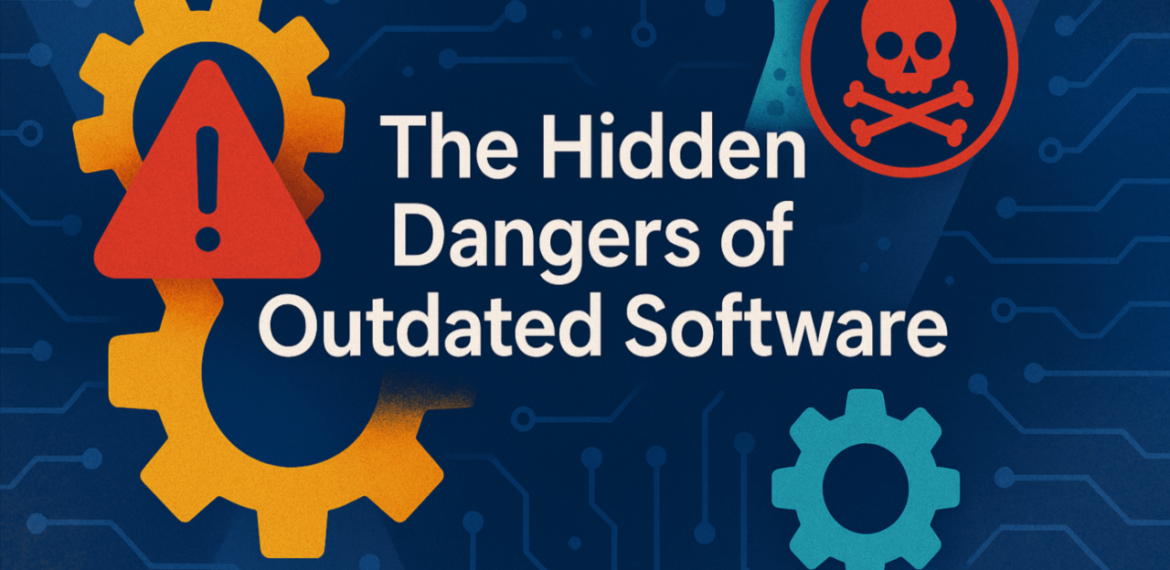
The Hidden Dangers of Outdated Software
The Hidden Dangers of Outdated Software
Why Patching, Automation, and Risk Mitigation Must Be Strategic Priorities
In today’s hyper-connected, always-on business world, software powers nearly every operational, customer-facing, and back-office function. From enterprise resource planning (ERP) systems and cloud apps to databases and industrial control systems, the digital infrastructure of a company is only as strong as the code it runs on.
Yet across industries, organizations continue to overlook one of the most preventable and costly threats to business continuity: outdated software.
Whether it’s skipping a critical patch or holding onto legacy systems for “just a little longer,” the failure to modernize and secure your software stack is more than a maintenance issue—it’s a growing cybersecurity liability.
Outdated Software: A Silent but Growing Threat
Too often, the risk of outdated software is underestimated or pushed to the bottom of the IT to-do list. But the consequences are far from benign:
- Unpatched vulnerabilities are a hacker’s playground. Threat actors constantly scan networks for known flaws, often exploiting vulnerabilities that have had fixes available for months or even years.
- End-of-life (EOL) software receives no security patches or support, creating permanent blind spots in your defense strategy.
- Compliance violations are a looming risk. Most regulatory frameworks mandate regular updates and vulnerability management.
- Operational bottlenecks emerge when outdated systems can’t integrate with modern tools, creating data silos, inefficiencies, and increased manual effort.
- Loss of competitive edge becomes a reality when competitors adopt agile, secure, and scalable digital ecosystems while your business is weighed down by legacy tech.
In short: Outdated software is one of the easiest points of entry for a cyberattack—and one of the hardest to detect until it’s too late.
From Reactive to Proactive: Why Traditional Patching Is No Longer Enough
Organizations often rely on reactive or periodic patching cycles, assigning IT teams the responsibility to manually track, test, and deploy patches. While this approach may have worked a decade ago, today’s environments are vastly more complex:
- Dozens or hundreds of apps span hybrid and multi-cloud infrastructures.
- Remote workforces access systems from unmanaged devices and networks.
- The average enterprise uses over 1,000 applications across departments.
- Threat actors exploit unpatched vulnerabilities within days of disclosure.
Manual patch management simply cannot keep up. It’s time-consuming, prone to human error, and lacks the agility required to respond to fast-moving threats.
Automation: The Backbone of Modern Patch Management
Security-conscious organizations are shifting toward automated patching systems that continuously scan for vulnerabilities, prioritize patches by severity and exposure, and deploy updates with minimal human intervention.
Benefits of Patch Automation:
- Speed and consistency: Critical patches are deployed in hours, not weeks.
- Reduced attack surface: Vulnerabilities are addressed before exploitation.
- Lower IT burden: Automation frees up staff for innovation, not firefighting.
- Audit-ready logs: Detailed tracking of updates supports compliance reporting.
- Scalability: Automation handles everything from a few endpoints to thousands of cloud assets.
Some advanced setups even integrate threat intelligence feeds and risk scoring to automatically determine the urgency of a patch based on exploitability and business impact.
Cyber Risk is Business Risk
It’s no longer a question of if a cyberattack will target your organization—but when. And when that moment comes, the difference between a minor disruption and a full-blown crisis often comes down to patch hygiene.
Outdated software isn’t just an IT oversight. It’s a strategic vulnerability that can lead to:
- Data breaches and ransomware attacks
- Regulatory fines and lawsuits
- Reputational damage
- Operational downtime and lost revenue
Organizations that treat software updates as a back-office task are missing the bigger picture: cyber risk is business risk. Executive leadership and boards must champion a culture of security and resilience.
Taking Action: A Strategic Approach to Patch & Risk Management
A modern, risk-based approach to patch management includes:
- Comprehensive asset inventory Know what software and systems exist, their versions, and support status.
- Vulnerability scanning and threat modeling Regularly scan your environment and correlate with real-world threats.
- Patch automation tools and processes Integrate patching into CI/CD pipelines and endpoint management platforms.
- Prioritization and risk scoring Don’t just patch everything—focus on what’s exploitable and business-critical.
- End-of-life mitigation plans Replace or isolate unsupported systems to reduce long-term risk.
- Security awareness and governance Ensure patching and updates are part of broader cyber governance frameworks.
Final Thoughts: The Time to Act Is Now
We live in a world where cyberattacks evolve faster than policies, where shadow IT creeps into every department, and where a single unpatched system can compromise an entire enterprise.
Automation isn’t just about efficiency—it’s about survival. A proactive, automated patch management strategy combined with continuous risk monitoring is not a luxury—it’s a necessity.
The organizations that win tomorrow are securing themselves today. Don’t let outdated software be your weakest link.
Let’s Connect
If you’re reevaluating your patching strategy or concerned about vulnerabilities hiding in your tech stack, feel free to reach out. At Buxton Consulting , we help businesses modernize their infrastructure, automate security workflows, and embed resilience into every layer of IT.

